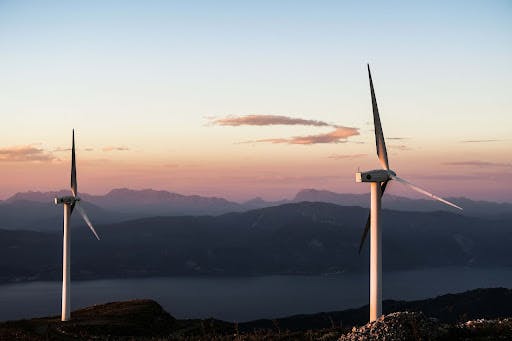Project Finance & Its Role In Renewable Energy Project Development
27 Mar 2023

Renewable energy project development is a costly business, often requiring significant upfront capital investment to get off the ground, which can be a big obstacle for many project developers. Coupled with the reality that renewable energy projects are often associated with longer payback periods, it becomes clear that traditional forms of financing aren’t always the best route to breaking ground.
It is for these reasons that project finance provides a viable route to market for project developers and investors looking to capitalise on the global green energy transition. “What is project finance?” you ask.
In this article, we’re going to answer this question, covering what it is, exploring key players in the process, and taking a look at the various project finance phases throughout a project lifecycle. Finally, we’ll tie it back to renewable energy project development and explain why project finance is critical to the success of the global renewable energy transition.
Table of contents:
- What is Project Finance?
- Examples of Different Project Finance Structures
- Key Players in Project Finance
- The Project Finance Process
- Access to Renewable Energy Project Funding
- Summary
What is project finance?
Project finance is a funding mechanism used to support the development of large-scale, long-term infrastructure and industrial projects that require large sums of upfront capital investments.
These types of projects often involve the creation of a special purpose vehicle (SPV), which is a separate legal entity with its own assets, liabilities, and legal status. SPVs are used as an instrument to mitigate financial risk for the parties involved.
Long-term financing for these projects is secured through a non-recourse or limited recourse financing structure. This type of project funding structure often includes elements of both debt and equity, with repayment of the funding secured through the cash flow generated by the project.
Investors, also referred to as sponsors, that provide access to funding are made up of financial institutions, private organisations, and government entities.
In the case of infrastructure projects, an SPV will be set up for every new project, with investors ‘buying into’ the SPV rather than the parent company. This is particularly important to consider when understanding the risks involved during the construction phase, since during this period there will be no revenue until it is built.
Examples of different project finance structures
Limited recourse financing
Limited recourse financing is often viewed as a middle ground between secured and unsecured debt. It’s sometimes also known as partial recourse debt. This means that the creditor can claim certain types of assets owned, but not all of them if the borrower is unable to repay the loan.
Non-recourse financing
In non-recourse financing, the creditor does not have a right to any of the assets outside of the SPV that are owned by the parent company if the loan is not repaid, except for agreed-upon collateral. The borrower retains all the other assets. The creditor can only take payment from the profits that the SPV assets generate. They cannot pursue any other income that the borrower may have (unless otherwise established in the contract).
Mezzanine financing
Generally used during the expansion phase rather than the start-up phase, mezzanine financing allows the creditor to roll up interest (often structured as “payment in kind” interest) and convert their debt into equity if the debtor defaults on the loan.
Key players in project finance
So, who are the key stakeholders in this type of deal structure? Let’s take a look.
Project owners
The project sponsor is the individual or business that comes up with the idea. Projects can have multiple sponsors, and they will generally need to find a means of raising capital to make the idea a reality. Usually, the sponsor will have some expertise in the area which makes them well-suited to running the project.
Lenders
The term “lender” often refers to the bank, debt fund or financial institution that will provide most of the money. This is who the borrowed money will be repaid to. The borrower (typically the sponsor) usually needs to demonstrate their ability to repay the money to this institution within clearly stated timelines (the ‘tenor’) and subject to key financial ratio benchmarks (‘covenants’) not being breached.
Investors
Not confused with lenders, investors provide money in exchange for equity in the firm. They tend to be more interested in the project’s upside over a longer time frame. The lender’s focus, on the other hand, tends to be more towards downside risks during the tenor of the loan repayment.
Contractors
An Engineering, Procurement and Construction (EPC) Contractor is sometimes involved during the construction phase. If one has been contracted, the EPC takes on responsibility for all aspects of the construction, including specifying the equipment, managing the sourcing of equipment, and physically building the project under a mandate with defined deadlines.
This allows the sponsor (who may not have construction expertise) to focus on other things until the facility is ready to start running. One of the major benefits is that the cost is agreed upon in advance, and the customer essentially gets a turnkey solution.
Regulators
Construction is a complicated process, and a regulator’s role is to make sure that it is being undertaken correctly, and in accordance with all local rules. Renewable energy projects need to comply with a large number of stipulations, and a regulator will ensure that this happens.

Project finance deal process
The route to closing and transaction can be complicated and lengthy, and it usually involves working with lenders/investors, contractors, insurers, advisors and sometimes regulators. Each of these will play a role in making sure that the project should be pursued, and that the execution is successful.
Below we’ve broken it down into three distinct areas: the pre-financial close phase, the financial close phase, and the post-financial close phase.
Pre-financial close phase
The pre-financial close phase generally involves three things.
Firstly, there’s the site selection and the feasibility analysis, which requires the project to be assessed from both technical and economic standpoints. Before this is completed, the project is entirely new and known as a “greenfield” project.
Next, compliance is dealt with: any necessary approvals or permits are obtained during this stage.
Finally, off-take agreements will be obtained. An off-take agreement means that you have agreed to sell a certain amount of energy to a buyer, which can make it easier to get financing for the project.
Financial close phase
Once the project has all necessary planning permissions, approvals, permits, and licenses, it becomes a “shovel-ready” project, also known as “ready-to-build” (RTB). The financial close phase involves two steps: documentation and funding.
Documentation, as you might expect, includes the signing of contracts, security documents, loan agreements, and more. At this point, it is a “notice-to-proceed” (NTP) project.
The funding step may involve lenders or investors, or both in some situations and is the stage at which the transfer of money from the financing commences.
Post-financial close phase
Finally, the post-financial close phase is when construction begins. The contractor will be responsible for overseeing the project’s construction, and keeping it on target in terms of budget and time.
The second part of this phase is the operation and maintenance part, which continues throughout the life of the project. This relates to making sure that the machinery is maintained and the project runs smoothly.

Role of project financing in renewable energy development
Renewable energy project financing is critical for a whole range of reasons. Let’s explore them in more detail.
Enabling renewable energy project development
Renewable energy projects tend to be expensive to start. As a rough guide, a large solar farm in the USA may typically incur construction costs of $800,000 per megawatt or more. Many sponsors will not have these funds available. Furthermore, if they tried to leverage their own balance sheet to obtain the funds via debt, they would still be restricted by the size of their own balance sheet.
Project financing, therefore, makes scaling these projects possible, giving companies and individuals opportunities to build multiple, large renewable energy sources. Without it, most of these projects would struggle to get off the ground.
Supporting the growth of the renewable energy sector
Renewable energy projects often have a relatively long return-on-investment period. This means that even once a project is started, it often cannot self-fund and expand for quite some time. Projects need to have access to ongoing funding if they are going to expand.
Even when they have begun generating profits, renewable energy projects may not have the capital that they need to expand. This makes it hard for them to take advantage of opportunities such as the sale of cheap land nearby. Ongoing funding is therefore critical if the renewable energy sector is going to continue growing.
Facilitating the energy transition to a low-carbon economy
Countries across the globe are looking to reduce their carbon emissions, and at the same time, global power demands are on the rise.
To meet increasing demands for energy whilst transitioning away from fossil fuel based sources, it’s necessary for the renewable energy market to dramatically expand – and project financing is likely to be the way forward for most projects.
If renewable energy projects are going to replace fossil fuels, massive investment is going to be needed. Project financing plays a key role in this.
Promoting energy independence
Promoting the development of renewable energy at a regional level provides governments reliant on energy imports to meet the needs of their population's energy consumption, an opportunity to wean themselves off of relying on energy export nations.
Countries like Italy have recognised this danger and are seeking ways to reduce their dependence on imported energy by increasing the development of renewable energy projects.
Not only does this promote energy security but also:
- Offers up opportunities for international investment
- Serves as a large-scale cost-cutting exercise with resources spent on importing energy available for redistribution to other pressing matters internally
- There is the potential to become an exporter of energy, adding additional revenue streams into government coffers
- Establish a new industry within a country, providing upskill opportunities and job creation
Project financing is therefore key to increasing the availability of regional-based renewable energy, and maximising the stability and security of energy provision across the globe.
Access to renewable energy project funding
Traditional routes to funding for renewable energy project developers can be time-consuming, and dependent on your network.
The PF Nexus marketplace cuts through the hassle, providing project owners access to investors and financial institutions looking for projects to invest in.
Our platform includes projects in utility-scale solar, battery, wind, and other sustainable and renewable infrastructure. If you’re in the process of seeking out project funding, why not take a look at our renewable energy project marketplace today.
Summary
As the world continues its transition to renewable sources of energy, greater levels of funding and investment will be required. Project financing provides a fantastic financial mechanism capable of servicing this need.
Drawing from a diverse range of funding sources and bringing together a myriad of different players, project financing offers a route to breaking ground for a range of capital-intensive renewable energy projects.